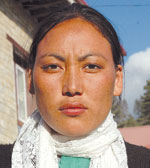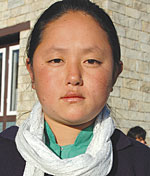 DAMBAR K SHRESTHA "My village doesn't even have a doctor, let alone a nurse. After I finish my course, I am going to take this knowledge back with me to Dhunche." Pramila Tamang, 19 Dhunche, Rasuwa |
Besides making medical treatment affordable for Nepalis, the biggest challenge in ensuring universal health care has been retaining doctors and nurses in district hospitals and village health posts.
Various strategies have been tried: increasing allowances, improving facilities, or adding training components for rural medical staff. But out-migration of health personnel to the cities and as nurses and caregivers abroad has continued apace.
In the last three years, Himali Health and Education (HHE) has started a training program in Phaplu of Solukhumbu to turn high school graduates into Auxiliary Nurse Midwives (ANM). The first batch had 40 students, mostly from Solu itself, but the second and third batch of 80 students are from remote districts across Nepal.
 "I will go back to Humla and work as a nurse because we have very high maternal mortality. Doctors and nurses don't want to stay in Humla, but I will work in my village because saving lives is more important than earning lots of money." Tsering Yangjin Lama, 20 Simkot, Humla |
"The idea was to make sure rural health workers stayed in the village," explains HHE's Dingma Thondup Sherpa. "That is why the training centre itself is in a remote area. All the students from the first batch are working in remote villages of Solukhumbu now.
The ANMs are trained at the Solukhumbu Technical School and come from Rasuwa, Mahottari, Rukum, Dolpo, Humla, Jumla, Bajhang, Bajura and Kalikot districts. Most trainees are Dalits, Janjatis and from remote districts where health care is rudimentary.
 "My village is two days walk from here, there is little education and awareness about health, we can't even get jivan jal for oral rehydration. My wish is to improve the health of my village." Tirsana Rai, 17 Cheskam, Solukhumbu |
The Phaplu centre has two fulltime trainers but also uses the service of the doctors, nurses and health assistants from the district hospital. "Historically we have seen that ANMs have a great impact on reducing maternal and child mortality in the villages, and our trainees will be contributing to that effort," says trainer DB Tamang.
In Solukhumbu itself there has been a surge in awareness about preventable infections that kill young children after the ANMs have been sent to remote health posts, Tamang says.
READ ALSO:
Sounding Solukhumbu - FROM ISSUE #489 (12 FEB 2010 - 18 FEB 2010)


